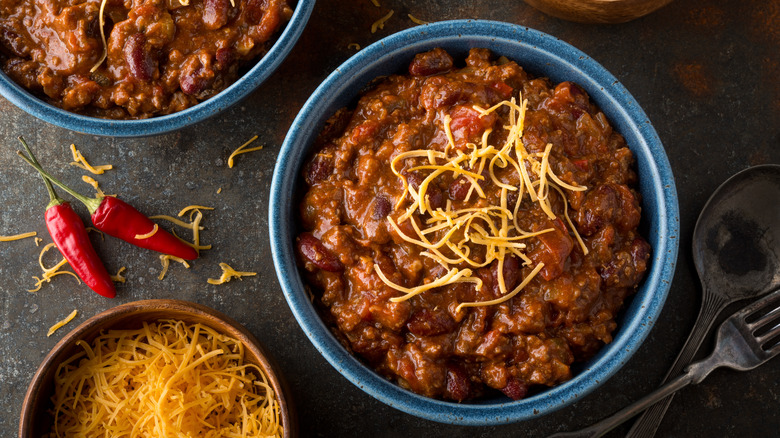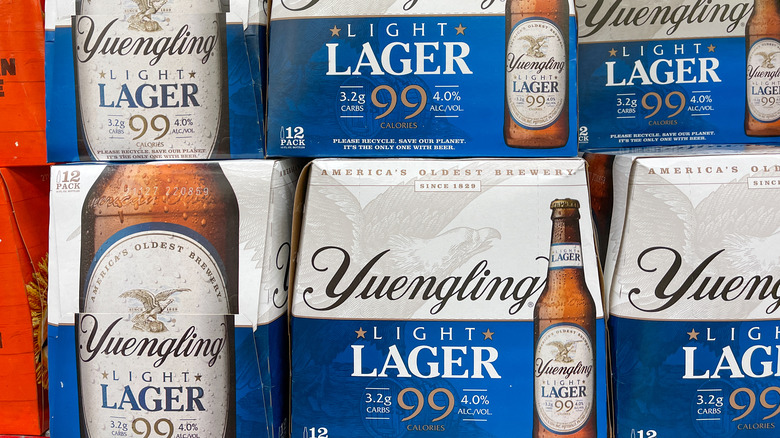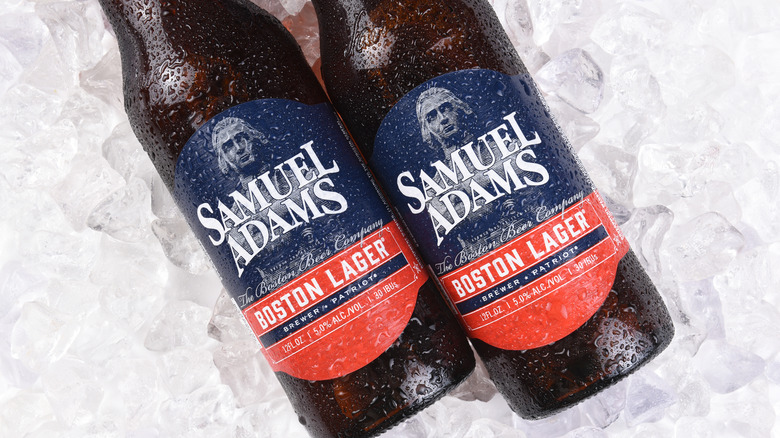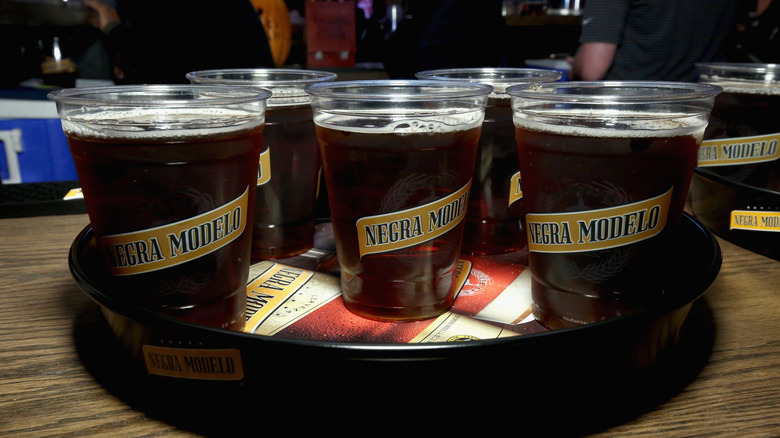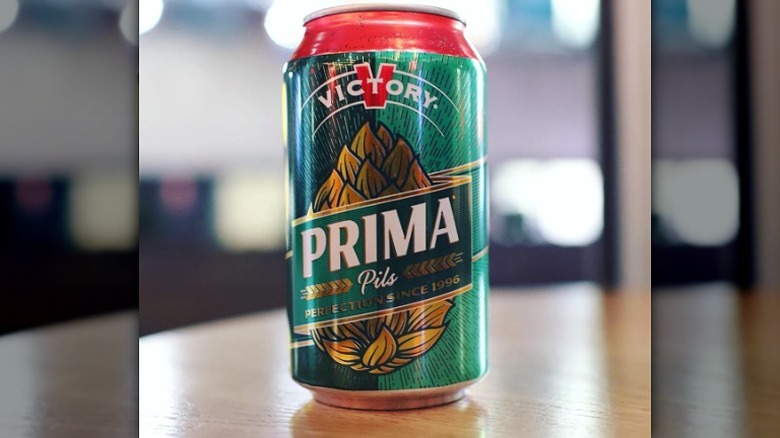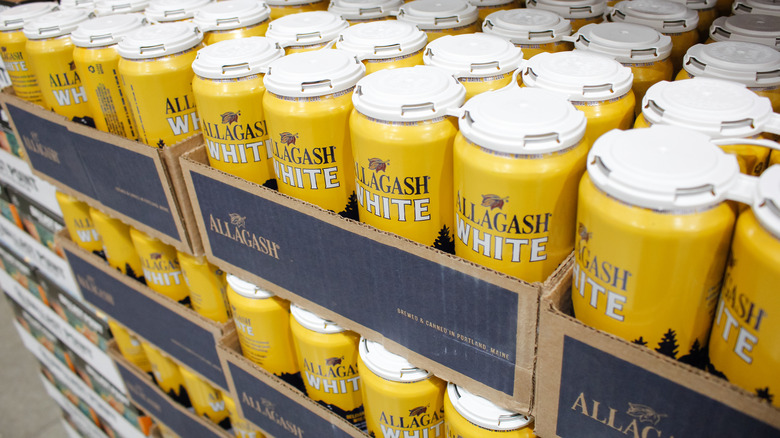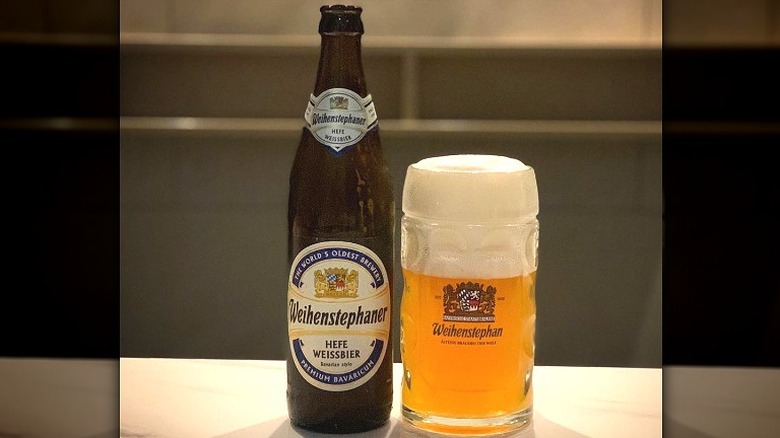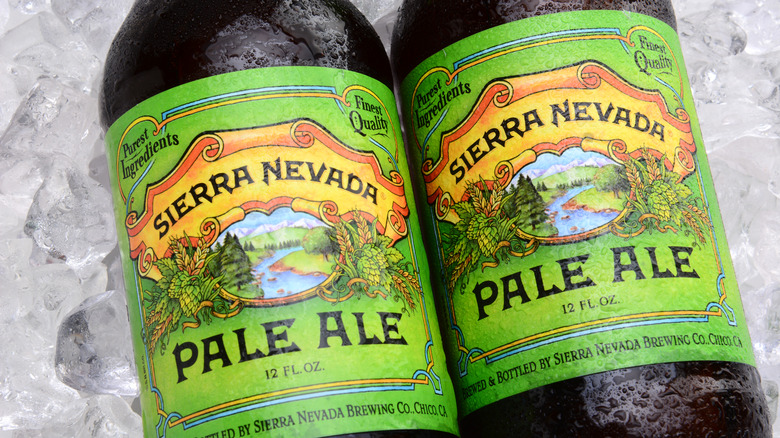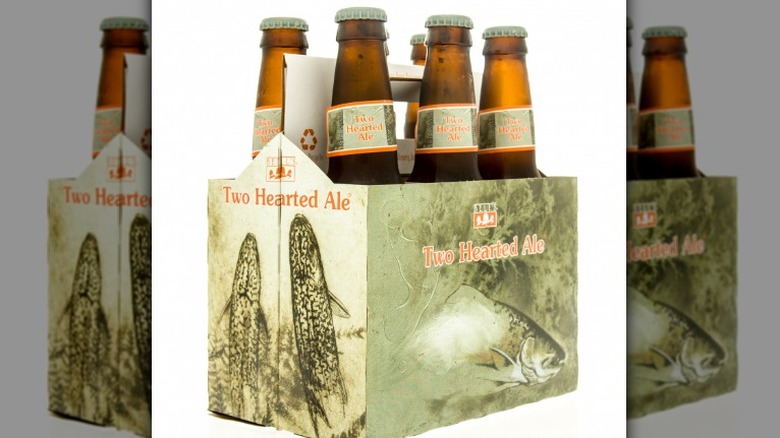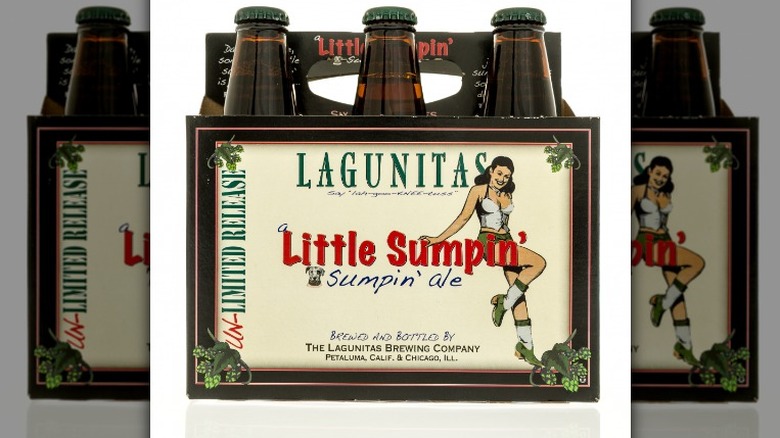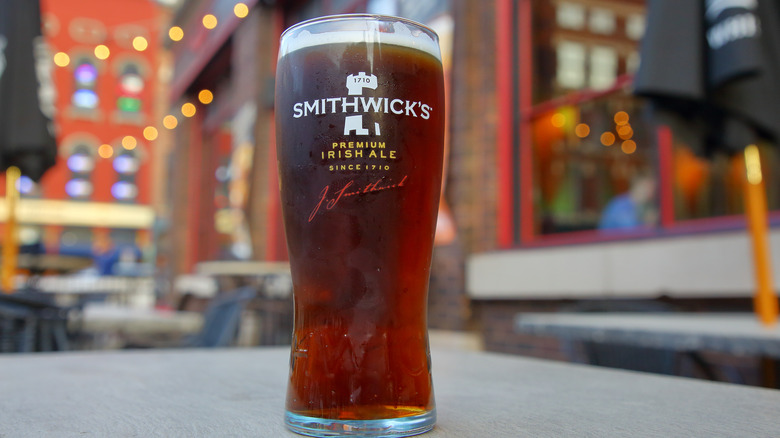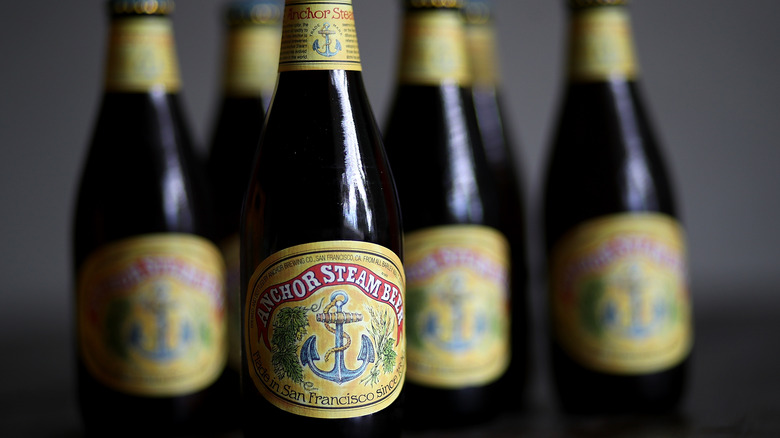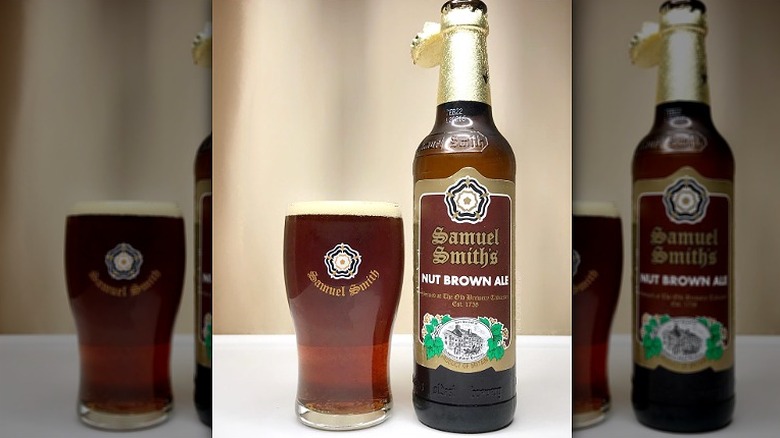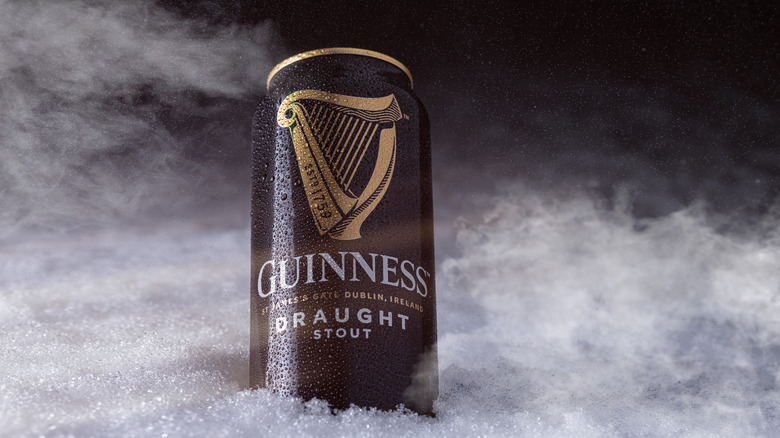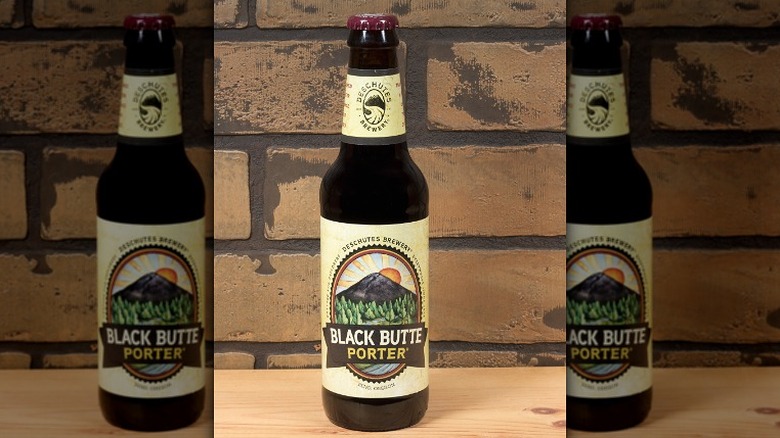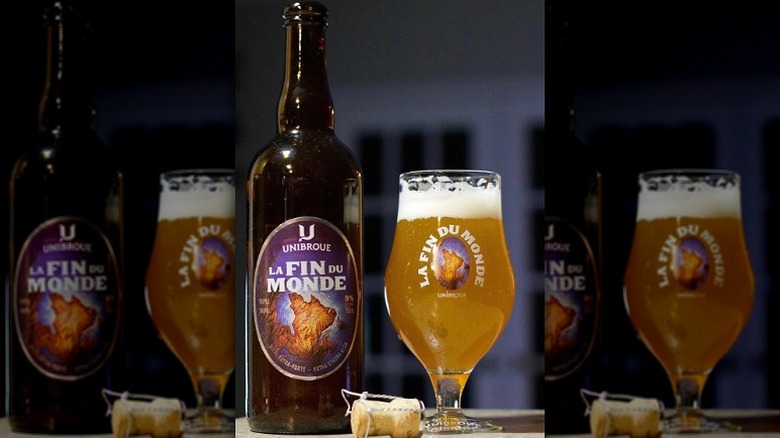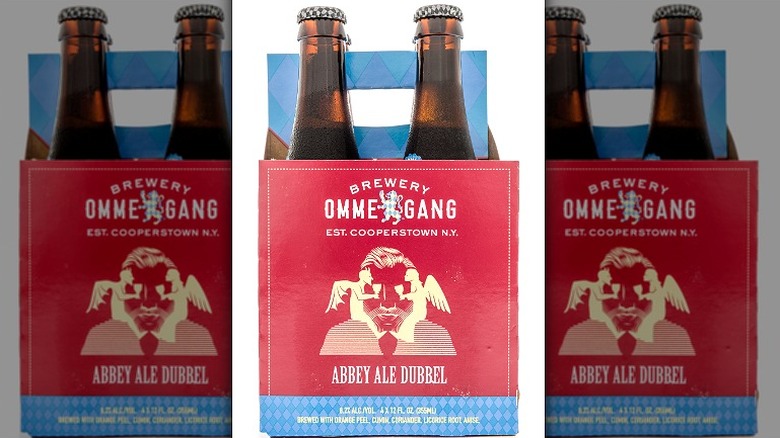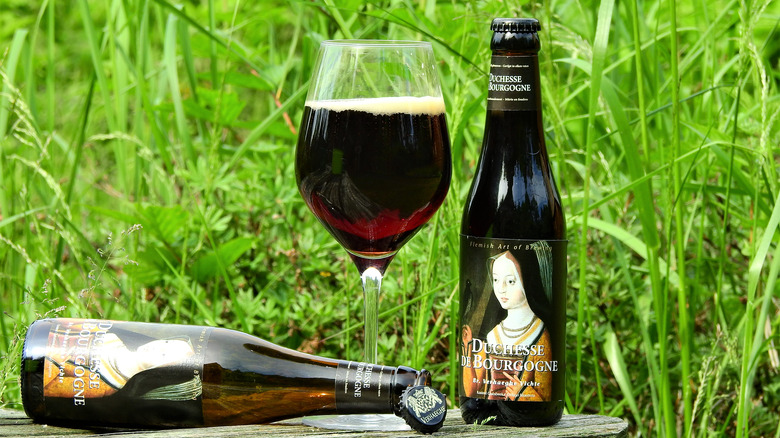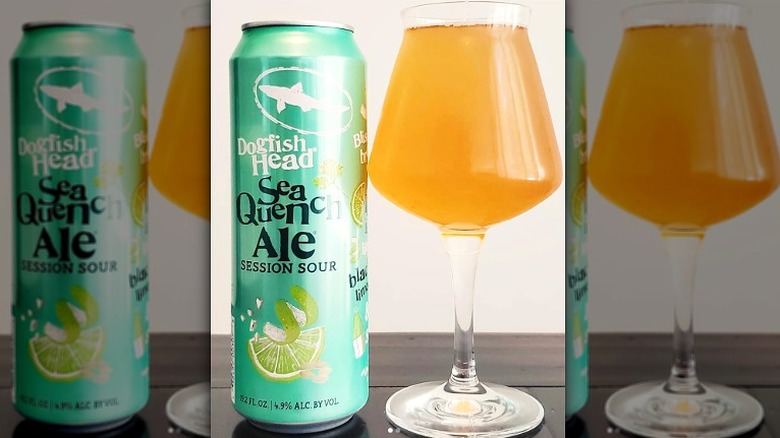19 Absolute Best Beers To Use In Your Homemade Chili
There are a lot of weird holidays out there, and some of them are pretty hard to get excited about. After all, who wants to celebrate Clean Your Floors Day or National Bubble Wrap Appreciation Day? On the other hand, National Chili Day is easily a holiday we can get behind, and there's no better way to celebrate on February 23rd than to whip up a batch of homemade chili.
Chili ingredients tend to be a hot topic, from whether or not it should contain beans to adding ingredients like chocolate or coffee to elevate your next batch of chili. One argument we can always get behind is adding beer to the mix. You don't have to be a beer enthusiast to use this ingredient, and you won't necessarily be able to taste the beer itself, but you'll find evidence that it's there. It tenderizes meat while also adding body, texture, and depth of flavor to soups and stews.
There are several beer styles to choose from, none of which are bad, but each impacts flavor by adding sweet, sour, or bitter nuances to the overall dish. These beers aren't ranked in any particular order, other than we start with light lagers and crisp beers and move on to the darker beers and Belgian-inspired flavors. The hardest part will be choosing which direction to go.
Yuengling Light Lager
Yuengling lays claim to being America's oldest brewery, hailing back to 1829 when a German immigrant began brewing beer in Pottsville, Pennsylvania. It wasn't until long after the brewery survived Prohibition that it began producing Yuengling Traditional Lager and Yuengling Light Lager, a 99-calorie version of the popular amber lager. We like either for making chili, but the light version has a lighter, cleaner finish compared to the original's stronger, heavier character.
What that does for chili is add a light level of toasted malt flavor to the chili without being overpowering. It's perfect for tenderizing the meat in the chili and thickening up the overall texture while only adding a mildly crisp, refreshing flavor that will influence the finished dish. If you've never cooked with beer before, this might be a good place to start.
Samuel Adams Boston Lager
Like other lager beers, this beer is fermented at cold temperatures, giving it a cleaner, crisper finish compared to ales fermented at warmer temperatures. But what makes Vienna lagers (like Samuel Adams Boston Lager) unique is the higher level of sweetness, reducing the hop bitterness to an afterthought and allowing smooth, bready notes to shine through. Samuel Adams Boston Lager is made with a malt called Caramel 60, which adds an extra toasty, caramel flavor.
That combination of flavors is what makes Samuel Adams Boston Lager particularly well-suited for chili. It does an admirable job of mellowing out a chili's spice, adding a toasted sweetness that accentuates the dish's meaty flavors. The malt profile here also adds a full-bodied texture to the stew, helping round out the mouthfeel even if you can't taste the beer.
Negra Modelo
One of our favorite beers to use in homemade chili is Negra Modelo. While most Mexican lagers are pale-colored and crisp tasting, this one is classified as a Munich Dunkel lager. The use of Munich malts deepens the color from a lager's traditional golden hue. That also gives it a maltier backbone than its lighter lager cousins, but it still finishes light despite the dark color since it's still fermented with lager yeast.
We love using Negra Modelo in chili because the dark malts create a toasted, nutty flavor that adds caramel notes to the dish. It also happens to pair perfectly with the caramelized character of seared meat. What really sold us on this beer is that it's included in Rick Bayless' chili recipe at Frontera. If it's good enough for one of the great masters of authentic Mexican cuisine, it's good enough for us.
Victory Prima Pils
Pilsners are similar to lagers — sharing a comparable yellow color and light finish — but they're characterized by an increased hop presence. That gives them a noticeably pleasant twinge of bitterness, although they do also have some sweetness. We specifically like Victory Prima Pils for cooking chili because this German pilsner has a heavily scented floral and citrus hop aroma from the use of German hops.
These flavors play well to accentuate the sweet and spicy aspects of your chili, providing a nice balance while also introducing an earthy element to the mix. The beer itself isn't heavy or bold enough to dramatically change the chili's flavor, but it accentuates the flavors brought by the other ingredients. This is an especially good choice if you add spicy peppers (like habaneros) to the mix, which contain fruity flavors in addition to their bold level of heat.
Allagash White
Belgian-style wheat beers (also known as witbiers) might be as light as a lager when it comes to color, but they're vastly different in flavor because they're fermented with a different category of yeast: ale yeast. In general, ales are not as crisp or clean as lagers, but they contain nuanced flavors gained during the warmer fermentation temperatures. In the case of witbiers, the combination of this yeast and the beer's predominant use of unmalted wheat in the mash results in fruity esters. That flavor is accentuated with added spices that also work well for chili, like coriander and orange peel.
Allagash White is an excellent addition to medium-spiced chilis, and the heavy herbal and citrus notes will accentuate the bowl's naturally peppery flavor. The heavy body of a wheat beer also brings a lot of texture to the chili, thickening it up so even the liquid components taste chewy. Because of the complementary flavors, we find this beer is particularly well-suited for white bean chicken chili recipes.
Weihenstephaner Hefeweissbier
German hefeweizens are similar to Belgian-style wheat beers in that both are made with a heavy concentration of wheat. It has a similar creamy mouthfeel to other wheat beers, making it a fantastic choice when choosing a beer to cook with. However, where a witbier contains a spiced orange flavor, hefeweizen yeast brings forward notes of banana and clove.
While adding these extra flavors to chili might sound weird, we've found that Weihenstephaner Hefeweissbier is a particularly good fit for spicy chilis. The banana-forward character mellows and gains a pleasantly sweet finish against the bold flavors of the chili, and hefeweizen works exceptionally well to bring spices like jalapeños or habanero to the forefront. You'll also get to brag that you cooked with a beer from the world's oldest brewery, which makes a good conversation starter with your guests.
Sierra Nevada Pale Ale
As we begin our journey into beer with hop presence, we stop first at American pale ales like Sierra Nevada Pale Ale. Unlike some hoppy beers, pale ales generally have a balanced level of malt, providing a finish that's not altogether light but wouldn't be called heavy. The hops are certainly there, bringing in bitter notes that can range from citrusy and floral to piney, resinous, or spicy, depending on the variety used.
In the case of Sierra Nevada, the use of Cascade hops means a grapefruit-forward aroma and a lightly fruity flavor. This beer is malty enough to bring a slight sweetness into your chili, but we advise taking care before you dump in the whole bottle. It's best to be careful when using hoppy beer with chili recipes, as bitter hops have a way of accentuating spicy food (which is why so many people love eating Buffalo wings with IPAs). Start with a splash and build from there; the finished dish might turn out spicier than you bargained for.
Bell's Two Hearted Ale
If you're a hop-head ready to dive into a world of spiciness, reach for an American IPA like Bell's Two Hearted Ale. These beers are decidedly hoppier (and therefore, more bitter) than their pale ale counterparts, and their higher alcohol content gives them a decided malt backbone and a smooth mouthfeel.
Bell's Two Hearted Ale is strong and bold, and the best way to describe the hop presence is "juicy." This 7% beer is hearty enough to hold up to the bold flavors of any chili, but be careful not to use too much beer here. Those pleasant flavors of citrus, grapefruit, and pine you taste out of the bottle will quickly turn bitter if the beer is allowed to boil down and concentrate. If your eaters are sensitive to bitter flavors, we recommend reaching for a different type of beer.
Lagunitas A Little Sumpin' Sumpin'
This beer is considered a specialty IPA (or white IPA) by the Beer Judge Certification Program, the program that provides guidelines for beer competitions for some of the best beer festivals in America. That means it has a hop presence similar to an American IPA but also features some of the same characteristics as a witbier. That makes it a good starting point if you haven't cooked with IPA before because it won't tend to get as bitter as it cooks.
Lagunitas A Little Sumpin' Sumpin has a smooth, silky texture that will add a really nice body to the chili. The hop bitterness is still pronounced enough to accentuate spice, so plan on using this one for mild chilis (or go for it with spicier blends, just be ready for it to provide a real kick to the taste buds!).
Smithwick's Red Ale
We love cooking with Irish red ales because they're all about balance. When you drink one, you're first greeted with a robust flavor that's rich with malt sweetness, bringing in notes of toasted caramel. It's not all malty flavor, though; Irish red ales have a dry finish that finishes lighter than porters or stouts, and a touch of hops is perfect for accentuating the spice in a medium chili.
There are several different red ales to choose from, but we like Smithwick's here because of its slightly sweet flavor and smooth finish. The use of roasted barley in this beer adds an almost coffee-like finish that enriches the earthy vibes of the chili, playing well with smoky spices like cumin or paprika. This beer also doesn't have a noticeable hop presence, so you can add chili peppers with relative impunity.
New Belgium Fat Tire
For years, New Belgium's Fat Tire was the epitome of an American Amber Ale. Any homebrewers who wondered what biscuit malt tasted like needed only to take a sip of this iconic example to identify the malt's roasty, toasted flavor. In 2023, New Belgium announced the re-release of this classic beer, changing the recipe to make it crisper and brighter.
Having tasted both versions, we feel confident keeping this Colorado-brewed beer on the list of the best beers to use in your homemade chili. It still retains a sweet, cereal-like flavor that enhances the richness of other chili ingredients, but its crisp finish doesn't add an overwhelming beer flavor to the finished dish. We recommend adding a little cayenne pepper to the chili when using this beer, though, to balance out those sweet notes.
Anchor Steam Beer
Anchor Steam Brewing is keeping an old-school San Francisco tradition alive with its trademarked steam beer that it's been brewing since the late 1800s. These beers got their name from the original cooling process, which involved leaving the fermenting beer outside overnight to cool (creating steam). While they're all brewed inside today, Anchor Steam still uses shallow, open-air fermenters. The other unique component of this beer is that it uses a lager yeast that's fermented at warmer ale temperatures, creating the flavor of an ale with the crispness of a lager.
At first taste, Anchor Steam Beer might taste similar to an American amber but with a noticeable hop presence that's both herbaceous and spicy. That plays well with chilis that have a balanced spiciness from chiles like ancho or pasilla peppers.
Samuel Smith Nut Brown Ale
As we delve into darker, deeper, richer beers, it's also time to consider using spicier chilies in your recipe. Since these beers have less hop presence, they're less likely to increase the spice in your bowl. Instead, dark beers have a concentrated sweetness thanks to the addition of the malted grains that provide the beer's color, which provides a nice balance for medium to high levels of heat.
A British brown ale doesn't have any roasted flavors (like you'll find in a porter or a stout), but it does thrive on nuttier, more caramel-forward flavors. As the name indicates, you'll get a lot of toffee-like flavors in Samuel Smith Nut Brown Ale, but it also has a lightly bready finish and a smooth consistency. Put that together with roasted chili peppers or browned meat, and you'll end up with an ideal combination of flavors. Brown ales also work well in chili recipes using chicken, too.
Guinness Draught Stout
Stout is a perfect base ingredient for stew because it combines the flavors of several "secret" chili ingredients into one, easy-to-add package: beer, coffee, and chocolate. An Irish stout like Guinness Draught Stout is particularly well-suited here because of the beer's roasted flavor and creamy texture.
Look for Irish stouts with a nitro can, like Guinness Draught Stout (or Left Hand Milk Stout, if you can't find the former). These beers have a creamier consistency that adds incredible texture to your chili. Because Guinness has a dry finish and a light hop presence, it will bring out spicy flavors more than other dark beers. Look to a pepper like jalapeños if you don't want to get too aggressive with the spice. Of course, this is the perfect opportunity to let fruity peppers like habaneros shine, so don't be afraid to be bold if you dare.
Deschutes Black Butte Porter
At first glance, it can be hard to tell the difference between a porter and a stout. Both are opaque and dark and share similar roasted flavors. The distinction comes from the type of barley used: unmalted for stouts and or malted for porters. Malted grains are allowed to germinate, converting the cereal grain's starch into sugar. In porters, that creates a more chocolate-forward flavor compared to stout's dry, coffee-like flavor.
Using an American porter (like Deschutes Black Butter Porter) will add rich flavor and creamy texture to any chili. It contains only the lightest level of bitterness (from the malt, not from the hops), so it won't do much to accentuate spice. Instead, the bold flavor holds up to very spicy chilies, so this might be the time to pull out that ghost pepper you've been waiting to use.
Unibroue La Fin Du Monde
Our final few recommendations revolve around the world of Belgian beers and sour ales. This twist may take you out of your comfort zone because of its strong flavors, but these beers can produce uniquely delicious chili. Belgian Tripels are considered Monastic ales by the Beer Judge Certification Program, a traditional style that was originally brewed by religious institutions in Belgian. You may also hear them referred to as Trappist ales.
Unibroue La Fin Du Monde is a Belgian tripel that's light in color but bold in flavor. When we first tried it, we were surprised at how smooth it is, which is what makes it particularly well-suited for cooking. Although it's a 9% alcohol beer, it doesn't contain the alcohol-related heat that you might find with other high-ABV beers. It also adds its nicely spiced, lightly fruity flavor to chili, rounding out and accentuating the other sweet ingredients in the bowl.
Brewery Ommegang Abbey Ale Dubbel
Although Belgian dubbels are darker and heavier than tripels, they are typically sweeter and rich with fruity aromas and flavors of dried fruit, like raisins or plums. And although dark in color, these beers finish dry and light, leaving the playful aroma of Belgian yeast esters on the palate.
In chili, Brewery Ommegang Abbey Ale adds a delightful fruit-forward element to the dish, bringing notes of ripe cherries and figs into play. It also has some nice earth and wood characteristics that pair well with roasted beef or game. We like using this one for chilies that use chunks of stew meat instead of ground meat, but we'd avoid it for chicken chilies as the flavors can overpower the delicate white meat.
Brouwerij Verhaeghe Duchesse De Bourgogne
It may not be a popular choice to cook with Flanders red ale (also called a Flemish red), but we can't help but recommend it as an addition to your homemade chili. After the brewing process is complete, these beers are aged in oak for up to two years. That makes these beers both sour and fruity, and they're more wine-like than most beers. It also means this beer is usually more expensive than unaged beers, which is why most people don't reach for it when cooking.
Brouwerij Verhaeghe Duchesse De Bourgogne totally works in chili, though. The beer's bright acidity plays well with the other ingredients: Acid reduces bitterness in food and brightens up other flavors, so it can counteract any bitter notes introduced by dried, smoked chilies or caramelized meat. The beer's oaky character will also bring woody flavors and a sweet-tart finish that rounds out a balanced chili nicely.
Dogfish Head SeaQuench Ale
Our final recommendation is another sour ale, but this one defies traditional classification. Dogfish Head Brewery describes its SeaQuench Ale as a mixture between Kölsch, Gose, and Berliner Weiss styles. This creates a low-alcohol beer with a crisp texture and a salty, tart flavor. It's refreshing to drink on a hot day, and it adds an incredible element of surprise to a bowl of chili.
We recommend tasting the ale before blindly adding it to the chili, just to make sure that it's your cup of tea. If it is, you'll love the way the tart citrus notes linger on your tongue before you're hit in the face with a surprising salinity. Put that together with sweet malt presence, and this beer can create an incredible balance of flavors that's perfect for a medium-spiced bowl of chili.
Static Media owns and operates Mashed.
